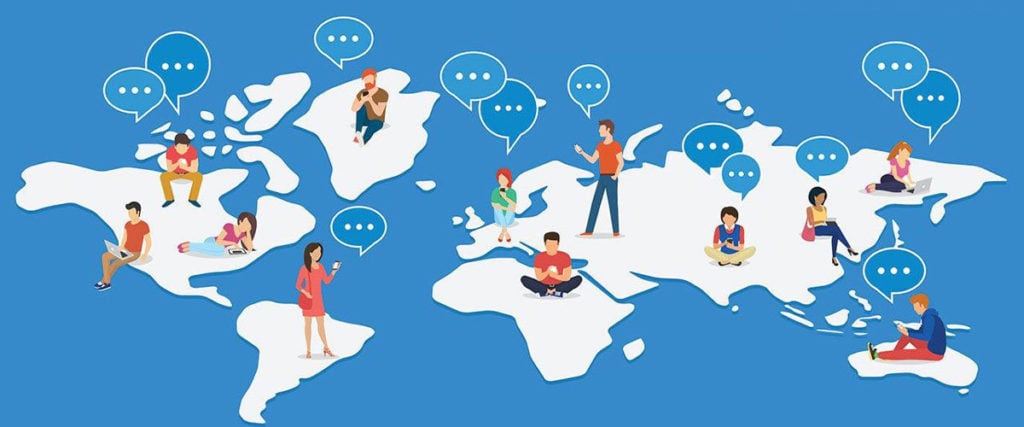A strong localisation strategy will help you scale up your business and expand internationally. Here are the 8 tips that you need.
Think about how you built your business in the first place. You had an idea for a product or service. You researched the market place to see if there was a want or need for it. You developed that product or service. Then, it was time to market your brand. Much of this was accomplished via the following:
• Website
An amazing website featuring your company, your product/service, and, of course, contact details for customers to get in touch with you, make purchases and ask questions.
• Social Media
You got on the social media platforms where your target customers hang out. You built a following by educating, entertaining, and inspiring, not selling.
• Advertising
You purchased advertising on channels where it would be seen by your target customers.
• Blog
You began a blog, populated with interesting and informative content.
• Email Marketing
You built an email list so that you could target hot leads and maintain relationships with current customers. And you crafted an email marketing campaign that was filled with great and engaging content.
All of these efforts involved fall under a broader umbrella of ‘content marketing’. And you had strategies for that content to ‘get the word out’ in the most effective and budget-wise manner possible.

8 Strategies for Content Localisation
Your next expansion now involves moving into global markets. Your strategy should be no different than the one you developed for your native market. You will need to do the same things but in a different marketplace.
Localisation is a process where you tailor your content to a local audience. You must go through the same steps as you did in your native country and for your native audience, but now things are different.
Here are 8 major steps to guide you through what you should do before you begin translating any content – and the factors you need to keep consistent with the rest of your brand, as you begin to scale.
#1 Research the marketplace
Obviously, if you sell snow boots, tropical countries like Thailand and Indonesia are not the markets for you. But, how do you know if your product or service will be popular in a specific foreign market? This is where the research begins. And this may be where you begin a relationship with a foreign consultant in the target language/country. Social media sites and search engines used in those places will give you an idea of popularity and somewhat of an idea of saturation of similar products or services.
#2 Find out where your foreign audience hangs out
Facebook is popular all over the planet. But, so are other social media channels and email providers. You will need to be well-versed on these things before you decide where and how to publish your content.
#3 Research the types and styles of content
For this, you will need a native speaker of the language – someone familiar with the local culture who can find typical and popular content in your market niche, and not just translate it for you, but also analyse the tone and style of that content. There are nuances in language, humour, etc. that need to be understood before the job of translation and localisation begins. Not only that, but the types of visuals that are appropriate for a cultural group must also be understood.
You might also like Brand Building: 6 Ways to Manage Your Social Media Reputation

#4 Keep your brand consistent
You must honour all of the cultural nuances of that target culture, but you also have to maintain your brand consistency. You may have to change some things, however. Your logo and brand colours, for example, may be offensive in some cultures.
And consider how much time and creative energy is put into product descriptions. Now think about how those descriptions can be translated and localised for a foreign audience. How do you keep that content engaging?
#5 Be authentic to a foreign audience
The holy grail of localisation is when your website, your social media posts, your blog, your advertising, your email campaigns, and any other content you’ve localised all make your company appear native to your target audience.
If you have searched for products or services and have a Facebook account, then you’ve probably seen ads for such products or services show up. And because of the content, you may have assumed that the company is American. The language, the photos, the ‘slang’ are all very ‘American’. However, when you go to order something, you may see that the shipping times are lengthy. This is an indication that the company has successfully localised its content, despite being based abroad.
You want to achieve the same effect with your content.
Obviously, a mere translation of your English content will never do. You will need to render the language, the visuals, dates, money, etc. all for that foreign audience. In some cases, you will need to have your content completely rewritten in the target language for it to be ‘authentic’ to that audience.
#6 Balance budget constraints with localisation expertise
Machine translation will not do. While technology has come a long way, machines will still produce a largely literal translation. Even if you alter images and colours, the content itself will seem stilted, impersonal, and, in some cases, just plain wrong.
A lot of the ‘big boys’ have made some big mistakes by using literal translations. The famous American advertising campaign ‘Got Milk?’ was translated literally into, ‘Are you lactating?’ in Spanish. Similarly, KFC’s ‘Finger Lickin’ Good’ slogan became ‘Eat your fingers off’ in Chinese.
Using machine translations or low-quality translation services will result in poor localisation and possibly some serious errors. You want a top-quality service like The Word Point – one that uses native human translators who will provide the right advice on localising your content, covering everything from language, style and tone to visuals and more.
This entire endeavour is not cheap. Businesses need to be realistic about the cost of crafting the right localisation of content. And that may mean that your goals need to be slightly modified, in terms of how many foreign audiences you can target at once.
The most important thing to remember is this: scrimping on translation and localisation costs will be money wasted. You will never capture the attention of a foreign audience if your content does not resonate with them.
#7 Effective email campaigns
You know that email is a consistent money maker. In fact, for every USD 1 you spend on an email campaign, there is a USD 40 return. Therefore, the same strategy should be applied to create localised email campaigns.
Localising your email campaigns will be a critical part of your content marketing in your foreign markets. However, all of your emails will have to be rendered for those foreign audiences. This will mean setting up a translator or agency on a retainer so that they can be sent out on a regular schedule.

#8 Prioritise your SEO strategy
Again, your strategy will have to be the same as that in your native country. This means you need the most popular keywords and keyword phrases used by your target audience. And they must appear strategically within the content – in the title, sub-headings, and naturally within the content itself.
You can spend time researching the highly ranked content of foreign businesses in your niche and looking for keyword phrases within that content. You can also conduct your own search via the most popular search engines of that audience.
However, it is worth noting that a native speaker could conduct that research far faster than you can. If you can afford it, it is worth the time saved.
Once you have your keywords/phrases, be certain that your translator integrates them into your content in very natural ways.
In Summary
These challenges present unique hurdles for businesses that intend to successfully expand into foreign markets. In short, you must:
• Establish Cultural Understanding
Make sure you really understand your audience and the cultural environment in which they live.
• Conduct Market Research
Conduct as much research as you are able to do yourself. If this is too burdensome and will consume too much time, contract a native speaker to do this for you.
• Seem Authentic
Have the goal of having a foreign audience see your website, your blog, your ads, your social media presence, and your emails as authentic, where you might even give the impression that you are a local company.
• Allocate Budget Accordingly
Be certain to develop a realistic budget that will allow you to use all of the expertise and reputable translation/localisation services you need. If you try to scrimp here, you might as well burn up your money.
Going global is a logical extension for your business’s growth. Doing it right can put you ‘on the map’ with foreign audiences and bring in great profit. So what are you waiting for?
Related Articles
Brand Identity: 5 Tips to Creating a Winning Brand Style Guide





